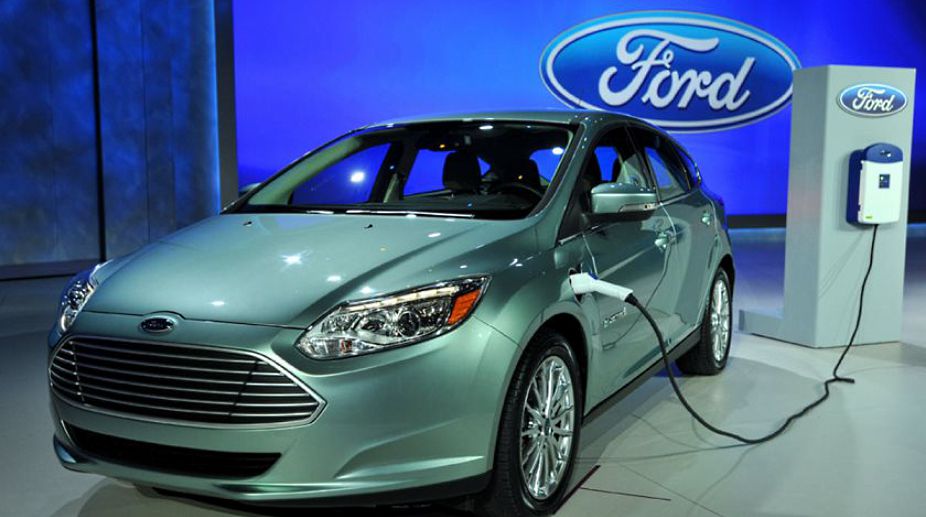Conventional Hybrids (CH) vehicles like the Ford Fusion Hybrid SE, combine both a gasoline engine with an electric motor. While these vehicles have an electric motor and battery, they can’t be plugged in and recharged. Instead their batteries are charged from capturing energy when braking, using regenerative braking that converts kinetic energy into electricity. This energy is normally wasted in conventional vehicles. Depending on the type of hybrid, the electric motor will work with the gasoline-powered engine to reduce gasoline use or even allow the gasoline engine to turn off altogether. Hybrid fuel-saving technologies can dramatically increase fuel economy.
.
Plug-in hybrid electric vehicles (PHEV) can operate on electric power alone for anywhere from 16 to 80 km. Once their battery power is depleted, plug-ins vehicles transition from running on electricity to being powered by the gasoline engine (just like the CH) mode to extend their range, allowing them to drive about as far as a regular car, and they can quickly refuel at a typical gas station as needed. But whereas the CH battery is recharged by the regenerating braking, the PHEV batteries are charged by plugging into an outlet. So why opt for a PHEV instead of a conventional hybrid? Well, unlike conventional hybrids, PHEVs can substitute electricity from the grid for gasoline.
Plug-in hybrids are an appealing option for drivers who travel short distances regularly to work or errands. But also have the benefit of a range change to get some distance when needed for your household, making it a good choice for a one vehicle household.
Battery Electric vehicles (BEV) are powered by batteries, 100%. This makes them very efficient, with most newer models having enough range to satisfy the needs of a typical urban driver for multiple days without having to fully recharge it. For most drivers, this means daily energy usage can be replenished from a simple 110-volt outlet, without the need to purchase and install a 240-volt charger. Battery Electric vehicles have fewer components than a plug-in hybrid or an internal combustion engine vehicle, and so they often have lower maintenance costs—no oil changes necessary!
You won’t need the expense of gasoline with an BEV, instead you are paying on your home electric bill for the charging. This electricity may present a good savings depending on your location as rates tend to be more stable than oil prices. Although rural customers have hefty electric distribution and transfer fees. And both electric and gas vehicle operators still pay a Federal carbon-tax. Gas owners see it at the pump and electric owners will have it added to their electric bill as their power supplier (they pay the carbon tax directly because they produce electricity from gas plants) passes that tax to the user. BEV owners will only see a reduction in carbon taxes when their power supplier uses renewable resources to generate the power to charge their batteries. Or the BEV owner uses a home solar powering system.
1.Battery Electric Vehicle Overview:
Lower Operating Costs
- BEVs may have lower energy costs depending on power prices in your region.
- Most BEVs have lower maintenance costs because they have fewer and simpler components and don’t require oil changes.
- When combined with a home solar system, “fuel” costs could be completely eliminated.
Lower Pollution
- BEVs produce no particulate or smog-causing tailpipe emissions, which are a significant contributing factor in causing asthma and other air pollution-related illnesses.
- BEVs have lower carbon emissions than gasoline powered vehicles over their service life.
Unique features
- BEVs are quiet, due to their lack of engine noise.
- Most BEVs provide instant power and can be fun to drive.
- Charging at home is convenient.
2.Recharging Basics:
Battery Electric vehicle owners need to have ready access to an outlet (or 240-volt battery charger) and a parking spot for overnight charging, unless they are relying entirely on workplace charging.
For BEV drivers, planning when and where the car will be charged is a constant part of ownership.
Unlike refuelling a gas car, which takes only a few minutes, recharging an BEV can take 25-60 minutes (depending on the battery size and charging speed) using fast chargers and several hours with slower, Level 2 chargers (see below for more details on levels). Note also that in cold weather or extreme heat, the range plummets dramatically.
Charge times vary greatly, depending on the size of the battery, how fast the car is able to take the charge, and the amperage of the circuit. For most BEV owners, charging overnight at home is the cheapest and most convenient option. Unless you are pushing the range limit on a daily basis, you won’t have to fill it up from empty all the way to full very often.
On a typical 240-volt, 30-amp (Level 2) charger, it takes between 9 and 13 hours to fully charge an BEV that can go more than 200 miles. Plug-in hybrids, with their smaller batteries, take significantly less time to recharge, about 2 hours.
Expect about triple those times when charging from a standard 110-volt (Level 1) household outlet. Put another way, on a standard household outlet, expect to get about four miles of driving for every hour of charging.
A wider variety of 240-volt chargers are coming on the market that charge at different speeds, with charge times that vary depending on the car and charger. And publicly accessible DC fast chargers are spreading throughout the country. These can replenish up to 50 percent of the battery’s range in 30 to 45 minutes. Zarowny Motors has one in St. Paul.
3.Driving Distances:
Most BEVs can now go more than 320 km on a full charge—much less than the typical 740-1030 km range for gasoline cars, however, hilly terrain and running the air conditioning in hotter weather can also exact a toll. And driving in cold weather will shorten the range noticeably, due to the power required to heat the cabin.
Driving an BEV requires planning. But plug-in electric hybrids have a combined gasoline and electric range of 640 to 885 km, and if you plan it right, you may never have to stop for gas during an average trip, except for long trips.
4.Home Charging Stations:
Both PHEV and BEV achieve the biggest benefits and cost savings when they’re charged overnight at home when electric rates may be lowest. Another benefit that most electric-car drivers say is that they find it much more convenient to just plug in at home than to have to stop at a charging station.
It’s possible to charge a plug-in hybrid overnight, even on a standard 110-volt household outlet. But it’s worth investing in a wall-mounted charger if you need juice quicker than 110-volts can provide and you don’t have convenient access to a public or workplace charger. Wall units are available online through Amazon, Costco, Home Depot, Lowe’s, Sam’s Club, among others. The cost is typically $500 to $700 US.
You’ll need a professional electrician to install a Level 2 charger. It entails putting a special 240-volt receptacle in your garage, like the ones used for a clothes dryer. HomeAdvisor shows that parts and labor, beyond the charger itself, costs $1,200 to $2,000 US.
5.Summary
Ask yourself the following questions to help make your electric vehicle decision.
- How many km do I drive each day?
- Do I have regular access to charging at home or at work?
- How much would the electricity costs be?
- Do I need a faster charging option, or can I charge overnight with a regular outlet?
- How often do I travel beyond the electric range?
- Are there charging stations in my local area or travel corridors?
6. Footnote
Conventional Hybrids largely beat out all-electrics in a new ranking of the most “environmentally friendly” cars, even as some automakers signal a turn away from hybrids for the future of their business. The scorecard, published Feb 3, 2020 by the American Council for an Energy-Efficient Economy (ACEEE), found that of the 12 cars that produced the least greenhouse gas emissions, nine of them were hybrids, compared to three all-electric models. Hybrids also constituted four of the top five vehicles on the list.
Another footnote is about the manufacturing of lithium for the batteries used in electric vehicles. Maclean’s magazine did an article in January 1, 2020 by Stephen Leahy that shed some disturbing light on the 3rd world locations that the mining for lithium takes place, the lack of environmental controls and low world supply of lithium needed to fulfill expected demands for these batteries.
Sources: https://www.consumerreports.org/hybrids-evs/electric-cars-101-the-answers-to-all-your-ev-questions/, Union of the Concerned Scientist, E & E News, Maclean’s

